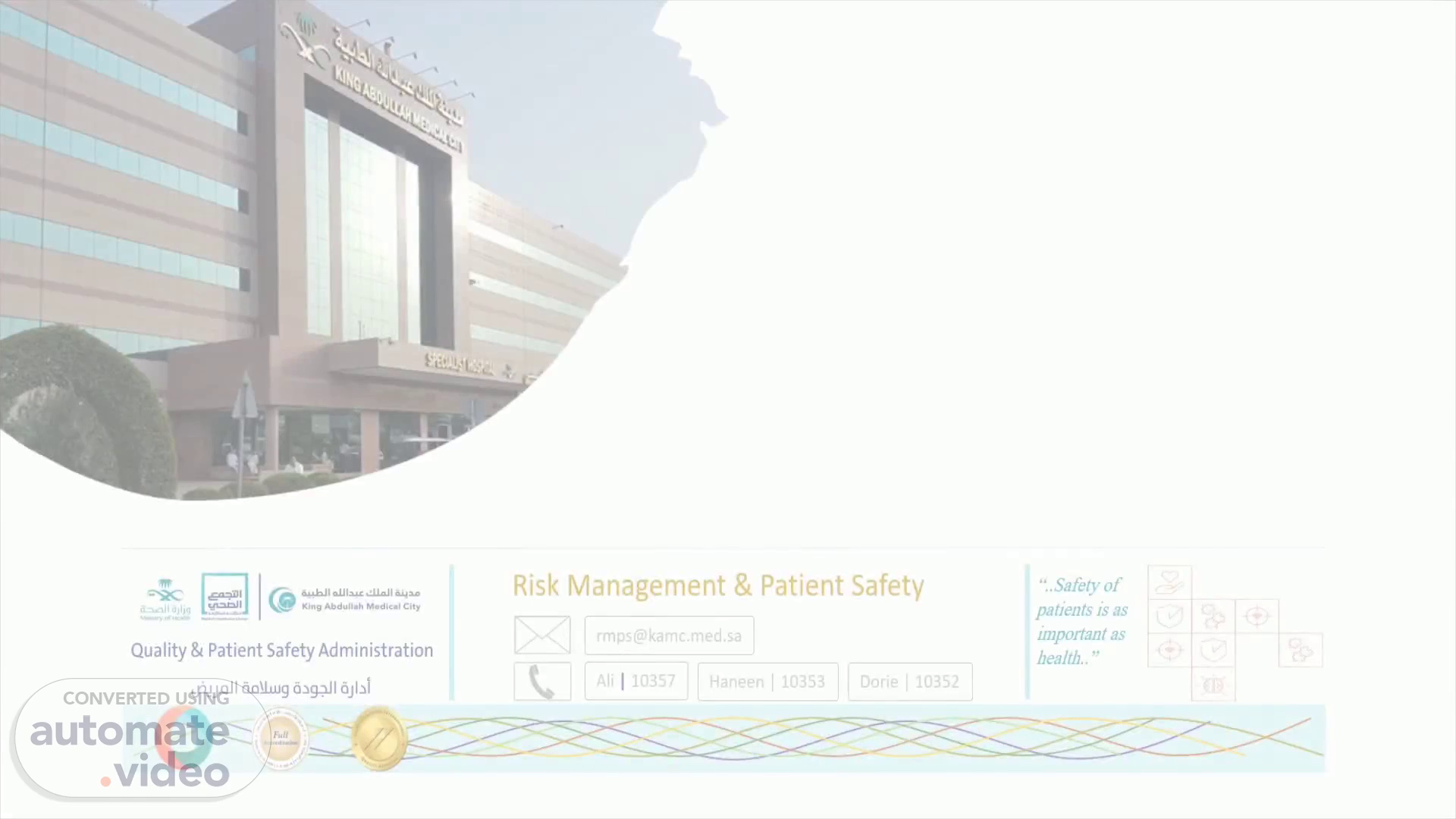
SentinelEvent-Education-02
Scene 1 (0s)
[Audio] Dear King Abdullah Medical City employee, we are pleased to present to you one of the.
Scene 2 (9s)
[Audio] Educational materials by the Quality and Patient Safety Administration and the Risk Management Department, one of the most important topic in patient safety.
Scene 3 (19s)
[Audio] In any healthcare organization, errors are considered inevitable in a complex system environment, though, some of the errors are considered catastrophic if caused major harm to the patient, and this is called "sentinel event", so.
Scene 4 (34s)
[Audio] What is Sentinel Event? It is defined as, A patient safety issue that is not primarily related to the natural course of the patient's illness or underlying condition of a patient that reached the patient and resulted in death, permanent or severe temporary harm..
Scene 5 (53s)
[Audio] Because Sentinel Event is out of the natural course of why the patient admitted! Its importance come to find out why it happened and how to improve the underlying systems and fix it to prevent it from happening again. In "King Abdullah Medical City", KAMC, we deal with all types of events in a "Just Culture" environment, with a focus on individual behaviors and accountability considerations. In "KAMC", there are policies and procedures to manage major events and "Sentinel Events" in order to mitigate the risks, and provide the proper correction action plans and improve the patient safety..
Scene 6 (1m 31s)
[Audio] There are Thirty criteria or category to consider Sentinel Event, and this is based on the Ministry of Health policy. You can check the full list of all Sentinel Events in the internal portal of KAMC, follow the link underlined..
Scene 7 (1m 49s)
[Audio] This is an example of sentinel event, where a foreign object left inside the patients body after completion of a surgery. Note that the criteria of retention of the object is known as unintended, whereas some cases an objects left inside the patients body intentionally such as stents, implants and some others medicaly decided by the surgeon during the surgery..
Scene 8 (2m 14s)
[Audio] Other example of sentinel event is when an operation done to wrong patient or wrong part.
Scene 9 (2m 26s)
[Audio] Or when wrong blood type is administered to the patient with or without reaction,.
Scene 10 (2m 39s)
[Audio] Or when a patient fall causes severe harm to the patinet such as bone fracture, brain hemorrhage or death.
Scene 11 (2m 53s)
[Audio] Or any medication error that leads to severe harm to the patient..
Scene 12 (3m 4s)
[Audio] There are Thirty Sentinel Events criteria listed here briefly in order to give you an idea however, you can access the full details by referring the policy mentioned earlier. This is the first twelve categories.
Scene 13 (3m 37s)
[Audio] Here are other categories. Please note that some of the categories may not match the Ministry of Health Definition of the Sentinel Event. This is called, Sentinel Event per say.
Scene 14 (4m 26s)
[Audio] So, its required by the Ministry of Health by criteria to be Sentinel Event for improvements reasons.
Scene 15 (4m 45s)
[Audio] Your role as a KAMC staff in any specialty, to report the sentinel event, you can initiate OVR or by communicating to Quality Department.
Scene 16 (5m 0s)
[Audio] The Risk Management Team, will screen the OVRs reported on timely manners and manage your report accordingly. If it meets the Sentinel Event criteria a special workflow will be initiated immediately in order to provide the appropriate corrective actions. Usually a root cause analyses will be the methodology to approach any sentinel event because its effective in such case..
Scene 17 (5m 25s)
[Audio] Any staff in any position or speciality can report events by using the electronic OVR system or other modes of communication with Quality Administration..
Scene 18 (5m 41s)
[Audio] In "KAMC", the general framework of managing any "Sentinel Event" consists of three stages. The first stage is "Identification" of the "Sentinel Event". This is the responsibility of the staff to identify the event and requires the staff to be aware about the types of "Sentinel Events" in the approved policies of the hospital. The "KAMC" staff have an access to the published policy of "Management of Sentinel Events" already available in the policies and procedures internal website. The second stage, is to report the event thru the proper system or the electronic "OVR" system as soon as you discover the event. You still can report the identified event, even if you are not sure if the event is categorized as "Sentinel" or not. In the third stage, the quality department, will run the suitable process to analyze the event, and usually it will involve the methodology of "Root Cause Analyses" in order to find the roots of the event, and put the proper actions in place to prevent from happening again. The approach is always focusing on the system failures rather than the persons or staff involved, however, keeping in mind the accountability of the individual staff behaviors. After implementing the actions of the recommendations of the "Root Cause Analyses", the hospital will have a lessons learned that could be circulated to all hospital staff and even for outside the organization..
Scene 19 (7m 10s)
[Audio] Thank you for your time, and hope that you have enjoyed our presentation. Please don't hesitate to contact us on the provided contacts. See you soon on another patient safety subject..